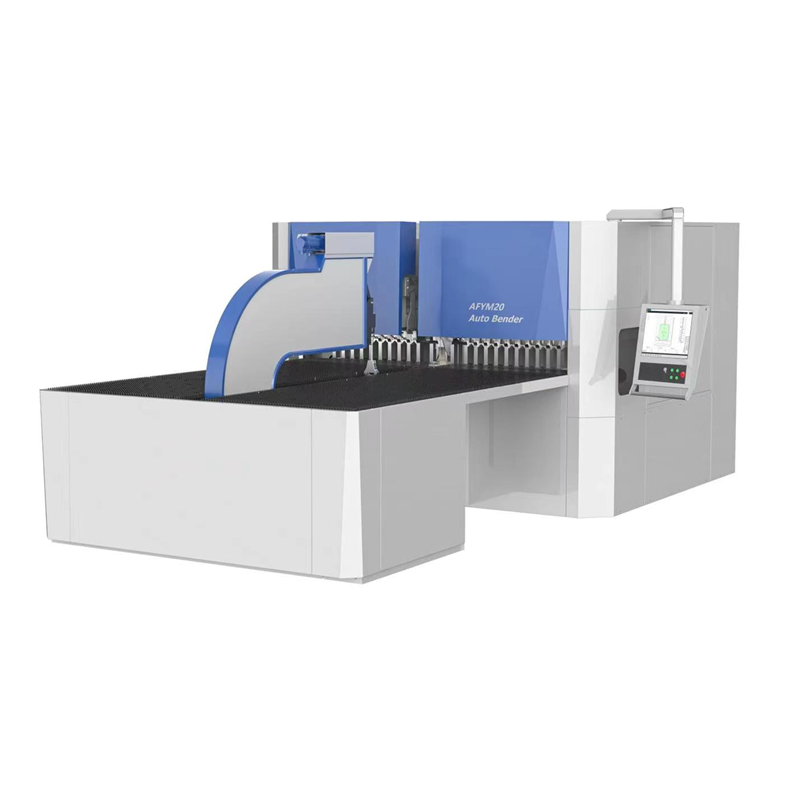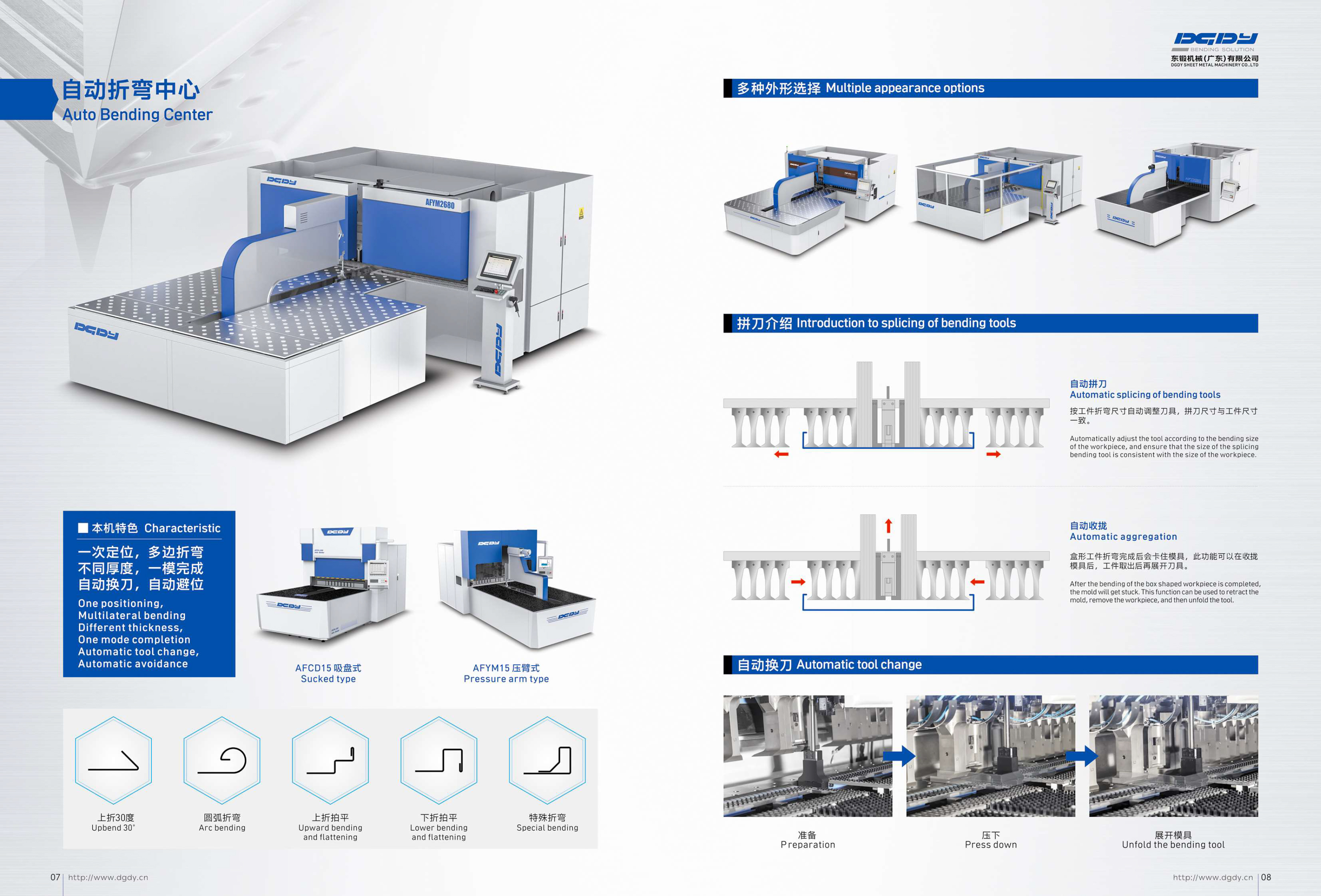1500mm CNC Panel Bending Center with automatic tool change and arm-type feeding is an advanced machine tailored for efficient metal panel bending, particularly suitable for manufacturing applications like door panels.
Key Features
CNC Control System:
Features a sophisticated CNC (Computer Numerical Control) system that enables precise programming and automation of the bending process, ensuring consistent accuracy and repeatability.
Automatic Tool Change:
Equipped with an automatic tool changing system that allows for quick switching between different bending tools or dies, minimizing downtime and enhancing productivity.
Arm-Type Feeding Mechanism:
Utilizes an arm-type feeding system that provides efficient and accurate placement of the panels for bending. This system improves handling precision and reduces the risk of damage during loading.
Maximum Bending Length:
Capable of bending panels up to 1500mm in length, accommodating various standard panel sizes commonly used in the industry.
One-Step Forming:
Designed to perform one-step forming of all four sides of a panel, significantly streamlining the production process and reducing cycle times.
High Precision and Quality:
Ensures exceptional dimensional accuracy and surface finish, crucial for producing high-quality panels.
User-Friendly Interface:
Features an intuitive control panel with advanced software for easy programming and operation, allowing operators to set up jobs efficiently.
Robust Construction:
Built from durable materials to withstand rigorous use, ensuring long-term reliability and stability during operation.
Safety Features:
Includes various safety mechanisms, such as emergency stop buttons and protective covers, to ensure operator safety during machine operation.
Benefits
Enhanced Productivity:
The combination of automatic tool changes and efficient arm-type feeding reduces manual labor and accelerates the production process.
Cost-Effectiveness:
Lower labor costs and reduced material waste contribute to a more cost-effective production process.
Versatility:
Capable of handling various panel sizes and shapes, making it suitable for a range of applications across multiple industries.
Quality Assurance:
Delivers consistent results with high precision, meeting strict quality standards and improving customer satisfaction.
Applications
Door Panel Production:
Primarily designed for manufacturing metal door panels used in residential and commercial buildings, ensuring durability and quality.
Furniture Manufacturing:
Suitable for producing components for furniture, such as cabinet doors and metal frames.
Automotive Industry:
Can be used to form parts for vehicles, contributing to body panels and other interior components.
Sheet Metal Fabrication:
Ideal for general metal fabrication needs, allowing for the efficient production of various bent metal parts.

| Item | Unit | AFCD15 | AFYD15 | AFCM15 | AFYM15 | AFYM16 | AFYM21 | AFYM26 |
| Bending thickness (stainless steel) | mm | 1.2 | 1.2 | 1.2 | 1.2 | 1.5 | 1.5 | 1.5 |
| Bending thickness (carbon steel) | mm | 1.5 | 1.5 | 1.5 | 1.5 | 1.5 | 2.0 | 2.0 |
| Rotatable diagonal | mm | 2000 | 2000 | 2000 | 2000 | 2500 | 2500 | 2950 |
| Min. bending size (length) | mm | 200 | 200 | 350 | 350 | 350 | 350 | 350 |
| Min. bending size (width) | mm | 170 | 170 | 170 | 170 | 200 | 200 | 200 |
| Max. bending height | mm | 200 | 200 | 200 | 200 | 200 | 200 | 200 |
| Bending angle |
| ±45° | ±45° | ±45° | ±45° | ±45° | ±45° | ±45° |
| Control the number of axes | Pcs | 9 | 13 | 15 | 15 | 16 | 18 | 18 |
| Downward speed | mm/s | 200 | 200 | 200 | 200 | 200 | 200 | 200 |
| Bending speed | mm/s | 40 | 40 | 40 | 40 | 40 | 40 | 40 |
| Motor energy consumption | kW | 5.5 | 6.0 | 6.5 | 6.5 | 8.5 | 7.5 | 10.8 |
| External dimensions (L × W × H) | mm | 4100 × 2500 × 2450 | 4100 × 2500 × 2450 | 4100 × 2500 × 2450 | 4500 × 2900 × 2600 | 4500 × 2900 × 2600 | 5500 × 3300 × 2900 | 6000 × 3300 × 2900 |
| Weight | Kg | 8500 | 8450 | 9000 | 9800 | 16500 | 18500 | 25100 |

CNC Press Brakes:
Description: CNC (Computer Numerical Control) press brakes use programmable controls to bend metal sheets into desired angles and shapes. They can handle various thicknesses and materials, making them versatile for different applications.
Features:
High precision and repeatability.
Automatic tool change capabilities.
User-friendly interfaces for easy programming.
Capable of bending large sheets with multiple axes of movement.
Applications: Ideal for producing complex parts, frames, and enclosures in automotive and manufacturing industries.
Manual Press Brakes:
Description: Manual press brakes require operator intervention for bending operations. They are often used for smaller batches or less complex projects.
Features:
Simplicity and cost-effectiveness.
Lower power consumption compared to CNC models.
Suitable for lighter gauge materials.
Applications: Commonly used in workshops and small fabrication shops for custom or small-scale projects.
Hydraulic Bending Machines:
Description: Hydraulic bending machines use hydraulic pressure to bend metal sheets. They provide powerful force, making them suitable for thick materials.
Features:
High bending force capability.
Flexibility to handle a range of sheet sizes.
Consistent bending performance.
Applications: Suitable for heavy-duty applications in metal fabrication and construction industries.
Electromechanical Bending Machines:
Description: These machines use electric motors and mechanical systems to achieve bending. They offer a balance between power and precision.
Features:
Energy-efficient operation.
Quick setup and changeover.
High speed and accuracy in bending.
Applications: Used in high-volume production environments where speed and efficiency are critical.
Panel Benders:
Description: Panel benders are specialized machines designed for bending flat sheets into box-shaped components in a single operation.
Features:
Automatic feeding and bending process.
Capability to bend multiple sides of a panel in one go.
High degree of automation, reducing labor costs.
Applications: Commonly used in the manufacture of enclosures, cabinets, and similar components.
Roll Benders:
Description: Roll benders use three rolls to form curves and arcs in metal sheets. They are typically used for creating rounded shapes.
Features:
Ability to create consistent curves and cylindrical shapes.
Adjustable rolls for different diameter requirements.
Applications: Often used in the fabrication of pipes, tubes, and curved structural components.
Considerations When Choosing Sheet Metal Bending Equipment
Material Thickness: Select equipment that can handle the thickness of the materials you will be working with.
Bending Angles: Consider the range of angles the machine can achieve.
Production Volume: Choose between manual and automated solutions based on the expected production volume.
Space and Size: Ensure you have adequate space for the equipment, considering its dimensions and the required operational area.
Budget: Determine your budget, as equipment prices can vary significantly based on features and capabilities.




















